A couple of weeks ago, while attending the Northwest Tea Festival in Seattle, a few tea connoisseurs hosted . . . after tea parties.
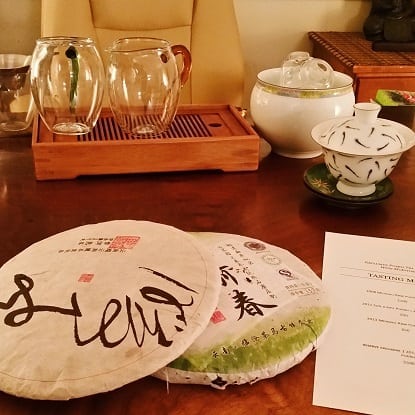
Basically tea parties removed from the regular events of the festival. One such small partyholder-to-be was my ol’ Agarwood puerh dealer, Jeffrey McIntosh. He planned to host two puerh tastings—one that Saturday night and one that Sunday.
I hadn’t planned on attending either of them. The reason? Well, I had no car that trip. And Teabook HQ was located a half-hour away from the Seattle Center and my hotel. The Uber ride alone—back-‘n-forth—would’ve run me $45.
Jeffrey even asked if I was going to either of them. To which I replied with a poor man’s, “Nope.”
Then he sighed [I think?] and said something to the tune of, “I can fetch your broke-ass, but you’ll have to get yourself home.”
Okay, he wasn’t that harsh. Actually, he was rather gentlemanly about it. But my ass was, indeed, quite broke. He fetched me shortly after I returned to the hotel, and then we were off.
Other folks showed up, gradually, bringing the total potential puerh-bingers-to-be to seven.

Not including the drug dea-. . . I mean, host.
The earlier day’s tea festivities had already left me plenty caffeinated. There was no way I was leaving the HQ with my full brain intact. Three puerhs were on the menu. Two sheng (raw) puerhs and one shou (cooked/ripe). The two raw puerhs hailed from a growing region called Mengku, while the ripe was a dual-year blend from the Menghai Tea Factory.
All of them were superb. Everyone of ‘em. Did I have a favorite? How the hell should I know? I was too busy giggling about capturing the actual, honest-to-Buddha twinkle in Jeffrey’s eye as he poured for us.
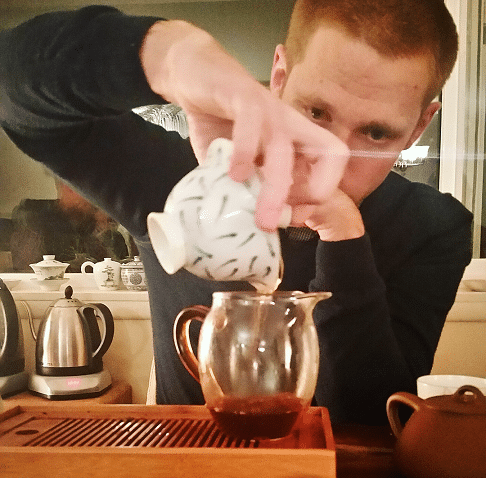
And if that weren’t enough, the night was capped off with several steeps of agarwood puerh . . .
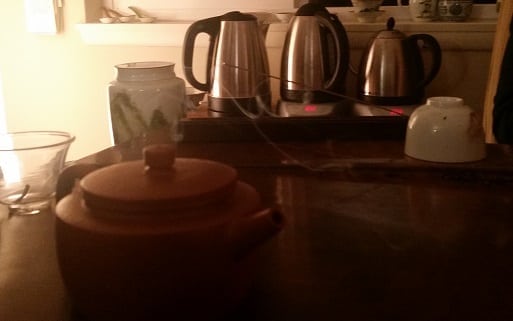
While an agarwood incense stick filled the room with the most pleasant of sweet-wood aromas.
Before the night was through, and while my mind was still somewhat lucid, I procured chunks of both the Mengku cakes for further “study”. I wanted to compare them back-to-back, but I wanted to do it while I had all my wits about me. It’s not that “tea drunk”-enness made me feel inebriated; rather, I was so busy with the entire sensory overload (and multiple thought streams) that it was difficult to pinpoint . . . everyday logic.
After an hour of caffeine decompression, I finally Uber’d back to the hotel. A day later, while at a NW Tea Fest tasting put on by Miro Tea, I encountered another Mengku puerh. This time, a shou (cooked) version.
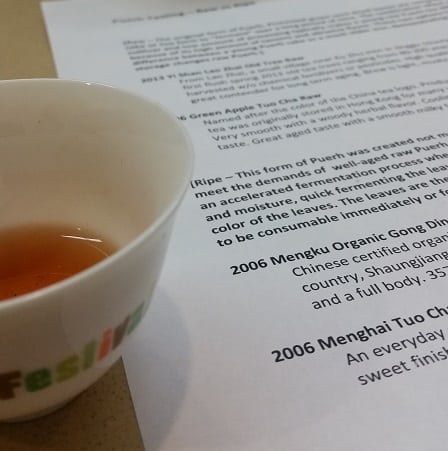
And I liked it quite a bit, too.
That made me even more eager to study the ever-living heck out of Jeffrey’s offerings. I just needed to do it on a day when I had the time to puerh-probe . . . properly. (Yay, alliteration!) A week or so after that, I finally got to both of the Mengku raw puerhs on my day off.
A little about Mengku.
It is the name applied to a specific tea growing region and township, as well as two tea factories in that region. The township is part of Shuangjiang county, which in turn is part of Lincang prefecture, in the southwest part of Yunnan province, China. The area shares a border with Burma/Myanmar. It is known for both its indigenous tribes, and their old-timey tea growing traditions.
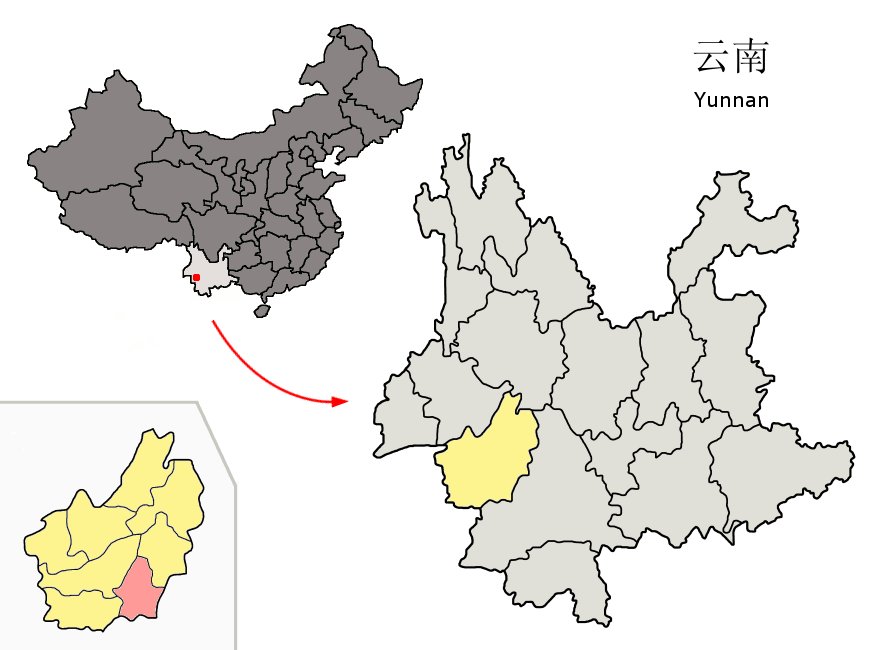
Shuangjiang is the little red area. Obviously.
Mengku is renowned for its forests of “mother tree” tea bushes (also called “mushu”).

No, not the Eddie Murphy dragon from Mulan.
“Mushu” refers to original tree cultivars that were allowed to propagate naturally. While some of the trees can range from anywhere between 50-800 (!!!) years of age; most aren’t considered ancient (or “gushu”) trees. However, their tree lineage is. Mengku puerhs of today are made with leaf material hailing from clones of trees that still retain the genetic material of their older, wilder, “mother” kin.

Mushu trees.
Make sense? No? Don’t worry, it barely does to me, either.

The two teas I had in my possession were made from mushu leaf material. One was still a young’un by puerh standards—a mere three years of age. While the other one was grown and pressed in 2008.
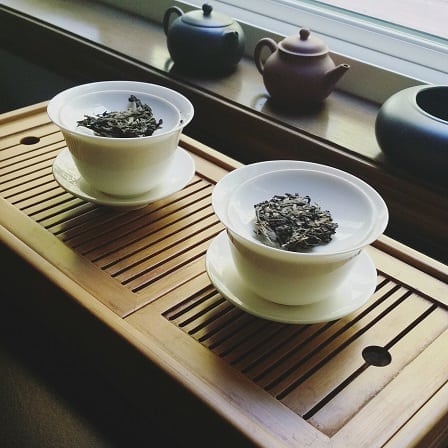
For brewing, my normal approach for quick puerh comparisons was to simply brew both teas for a minute and call it a day. This was a more special occasion, though, and required further study. So, I went with a more in-depth gongfoolish approach. One cake chisel to a gaiwan, water brought to near a boil, and short, successive steeps at around thirty-to-forty seconds each. Time-consuming, sure, but some things just shouldn’t be rushed.
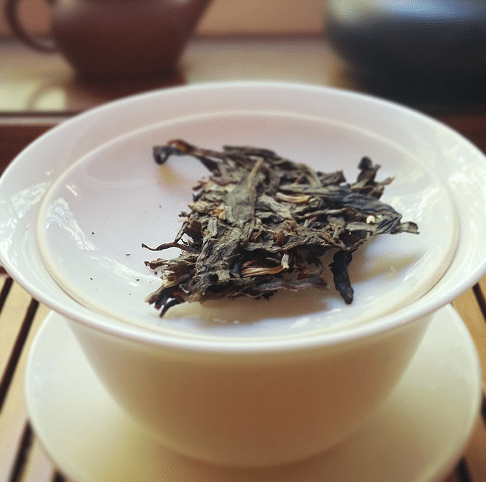
The 2013 chisels looked like . . . just about every other raw puerh cake I’ve sipped to death. The pressed leaves ranged from light-brown or beige, to forest shades of green. Still a rather young appearance, even with a couple of extra years under its belt. The smell the cake piece gave off was vanilla, mint and sage. My omnivorous mind imagined how vegan ice cream would smell. All in all, still a very “new”-seeming puerh.
The liquor brewed surprisingly bold amber right from the get-go. First infusion? Boom! Bold amber. Like, “Jurassic Park-mosquito-encased-in-“. . . amber. The first infusion had a hay-like introduction, but that smoothed out into a feeling of—oh—foreplay with a forest sprite. (Whoah, where did that come from?) Er, back to actual taster notes . . . um . . . nope, that’s pretty apt, actually.
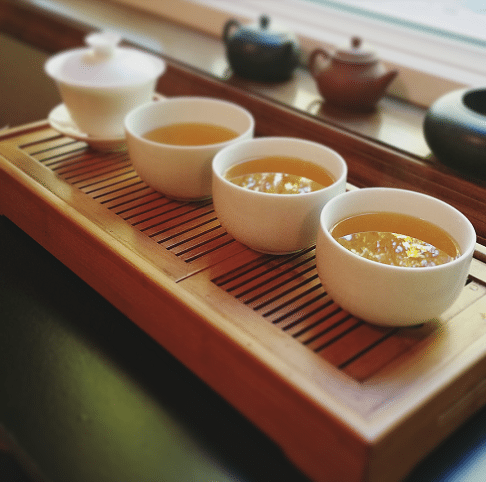
Further infusions tasted like someone distilled an herbal liquor from a tree made entirely of velvet. There were no signs of necessary roughness, it was just smooth sailing along my palate. Pure, blissfull feels rushed up my head and out my third eye. If that makes any sense. Probably the quickest transition to tea drunkenness I’ve ever experienced—ever! And I’m an authority on the subject.
Er, mister officer.
At this point, I wasn’t even sure moving on to the older batch was such a good idea. I was already far gone from just three infusions of the 2013. But . . . I had a job to do, gosh-darn-it.
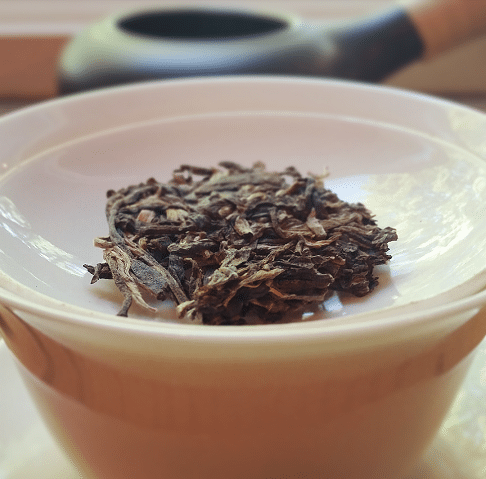
The 2008 cake piece, on the other hand—while it looked the same—had a much more robust aroma. Sure, it had that whole vanilla-mint-sage-vegan-ice-cream thing going as well, but it also had notes of peat moss, and an inherent woodiness. Like someone made a vegan ice cream float in a barrel full of tea-infused . . . whiskey? Yeah, we’ll go with that. There was also a faint fragrance of cassia on the back-whiff. In other words, a much “older” scent, without coming across as musty. On closer examination, too, the leaves did have a bit more browning to them, in contrast to their younger cousin.
The older Mengku yielded a similarly well-ambered liquor, but it was considerably darker, bordering on light crimson. A very Darjeeling second flush sort of color; and it only got darker as the steeps went on. The steam aroma was also tantalizing, imparting sweetness and smokiness in equal measure—with a strong trail-off of vanilla and cinnamon bark. As for flavor, the first infusion tasted aged puerh-y enough. It was smooth, it was earthy, it wrapped my brain in an electric blanket; the usual. Further infusions, though? Whoah. Yunnan heichas may vary widely from region to region, mountain to mountain, and the climate is versatile in each of these areas, but there’s still a general sense of, “Yep, this is a sheng puerh.”
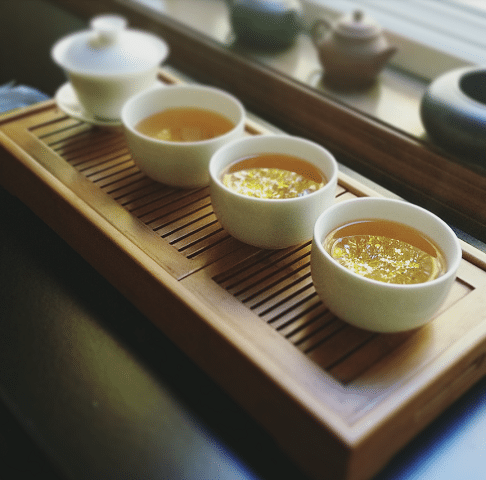
Steeps two and three? They didn’t taste like puerh. They tasted vaguely like Hunan heicha—Tian Jian came to mind. There was a toasty aspect on introduction that reminded me of that particular pine-roasted dark tea. Of course, once that perplexing intro was over, I was back on familiar puerh footing. Creamy, mythical forest, happy brain juice.
Was there a favorite? The ’08, obviously. But only by a leaf-hair. Both were bliss-inducing, tasty, and . . . did I say bliss-inducing, already?
Well, so much for a normal puerh study session. Then again, what’s the fun in that? It was a puerh party of one . . . and I was still okay to drive home.

Oh wait . . . I was home.
To buy the 2013 or 2008 Mengku puerhs mentioned above, go HERE.

Marilyn
For some reason I get lost with all the stuff about puerh’s, but slowly learning. Thanks for the education.
lazyliteratus
I’m STILL lost even after having written about it.
Xavier
Jurassic Park and a tea that turns you into a ghost (I have a proof, I saw your picture :P)? This is really something for me but Pu Erh is not yet my favourite tea (but I am slowly learning).
lazyliteratus
You can’t prove anything. *hehe*
Xavier
I can. I have everything to proof it.
Lord Devotea
“Foreplay with a forest sprite”? You’ve mellowed and toned it down.
lazyliteratus
It’s the old age settling in.
Scott Bond
Fun to read about tea with Jeffrey, thanks. I agree that the ’08 Mengku is a fabulous puer.
lazyliteratus
Agreed. Fabulous, indeed.
Notes on Tea
“‘Yep, this is a sheng puerh.'” I say this when I drink sheng. It’s such a good taste and feeling.
lazyliteratus
Most of the time, it is.
Most.
Cwyn
If the 2008 was so fragrant, Jeffrey is storing properly. Did he share anything about how he stores teas?
lazyliteratus
The cakes were originally stored in Taiwan for several years before being brought to Seattle. Beyond that, I don’t have any details. Although, I do know that he has a preference for dry storage.